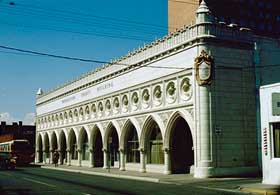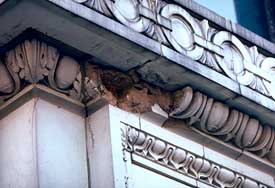Background
If you have looked closely at historic buildings of any architectural significance, you have likely seen architectural terra cotta. Though it is not used nearly as much today as it once was, terra-cotta was very popular between the 1890’s and 1930’s and was significant in the development of the Chicago Style, High Rise, Historic, and Beaux Art Styles in this period.
As the cost of decorative stone elements and especially stone carving became too expensive, the development of terra cotta became a practical solution. Stone elements could easily be replicated with this man made material and architectural details became almost limitless. Terra Cotta became widely popular due to the fact that it was durable, less costly than stone, and could be easily molded or shaped into elaborate building features.
What Is It?
Terra Cotta has two components: the interior bisque, and the outer glaze. The hollow bisque is composed of weathered or aged clay which is mixed with sand or pulverized fired clay called “grog” and then glazed and fired in molds at a high temperature. The outer glaze is an aqueous solution of minerals which are brushed or sprayed onto the units. This glaze provides a protective, impervious surface which possesses excellent weathering properties. The glaze can also be colored or textured to provide architectural value. Terra cotta was typically “hung” on buildings with carbon steel and wire anchors and then mortared into place.
Terra-cotta can very difficult to identify which is why it is often mistaken for other materials such as concrete, stone, or granite. Terra-cotta was once very attractive because of the fact that it could be finished to imitate stone. Another unique quality of terra-cotta is that it has been used in two separate and very different types of building systems: a traditional load-bearing masonry wall in buildings of modest height and as a cladding material in High Rise construction.
Common Deterioration Problems
Deterioration in terra cotta can be put into two categories: stress related, and moisture related. Below is a list of typical types of deterioration from each:
Stress Related Deterioration:
-Faulty original craftsmanship
-Introduction of new loads to the unit
-Damage caused by improper repairs or alteration
Moisture Related Deterioration:
-Crazing (fine cracks in the glaze)
-Glaze or Bisque Spalling
-Deterioration of Mortar
-Corrosion of Metal Anchoring
It is important to understand the causes of deterioration because no two buildings are the same. The most common cause of deterioration in terra-cotta is usually moisture-related, which can cause a domino effect of damage because once moisture enters the bisque it can be trapped behind the glaze causing further issues as well as causing corrosion of its anchoring system which in turn can apply stress to the terra cotta unit.
Identifying Deterioration
Inspecting terra cotta for deterioration is difficult due to the fact that deterioration is insidious, with the outside of the unit not always indicating the more serious problem located within (such as deteriorated anchors). It is critical to understand the composition and behavior of terra cotta, therefore, inspections should always be performed by an expert in terra cotta restoration. Early signs of deterioration can be easy to spot such as: glaze delamination, cracks, chips, displaced pieces, or rust stains. If you see these items, do not turn a blind-eye. Sub-surface exploration should always be performed to better understand the causes of the observed damage.
 Maintenance, Repair, & Replacement
Maintenance, Repair, & Replacement
Repairs to terra cotta should only be performed by a restoration expert with a proven track record in repairing terra cotta. It is very important that the repair specialist understands what type of repair materials should be used and how to properly install them.
Terra cotta should be gently cleaned to expose true surface conditions, colors and details. Deteriorated mortar joints should be properly repointed because the mortar joints are the first line of defense against moisture intrusion between the units as well as a way for moisture vapor to escape out of the wall system. The compressive strength of replacement mortar should be equal to or less than that of the original mortar and should be compatible with the terra cotta. If re-glazing the terra cotta after repair, be sure not to coat over the mortar joints, as these are the location where moisture exits the façade.
Be sure to inspect all of the units for crazing and delaminations. Determine if the delaminations are in the glaze or also in the bisque which will modify the repair strategies. Repair the units with a proper and compatible patching compound that has similar expansion and contraction coefficients and vapor transmission properties as the original. Fractures should be treated according to their behavior. Static cracks (non-moving) can be sealed with a high modulus sealant or patching material. Dynamic fractures (moving) must be sealed with a low modulus sealant which will allow the units to expand and contract but remain watertight. Supplemental anchors may also need to be used if the units are to be welded back together.
Displaced units should be reset utilizing stainless steel anchors, and missing units should be replaced with new terra cotta units. Replacement can be an expensive process which includes the creation of new molds to replicate the size of the original unit. The replication of the glaze can be a tedious process because no two pieces are exactly the same due to the manufacturing process. Lastly, applying a protective glazing can provide not only a uniform appearance, but can also bridge hairline fractures in the glazing and help prevent moisture intrusion.
Do you need assistance when it comes to the repairing and replacing of the terra-cotta on your building? We would love to give you some guidance or take a look at your structure to offer some suggestions. To reach our experts at Trisco Systems, Inc., call 419-339-3906.
Source: http://www.nps.gov/tps/how-to-preserve/briefs/7-terra-cotta.htm

